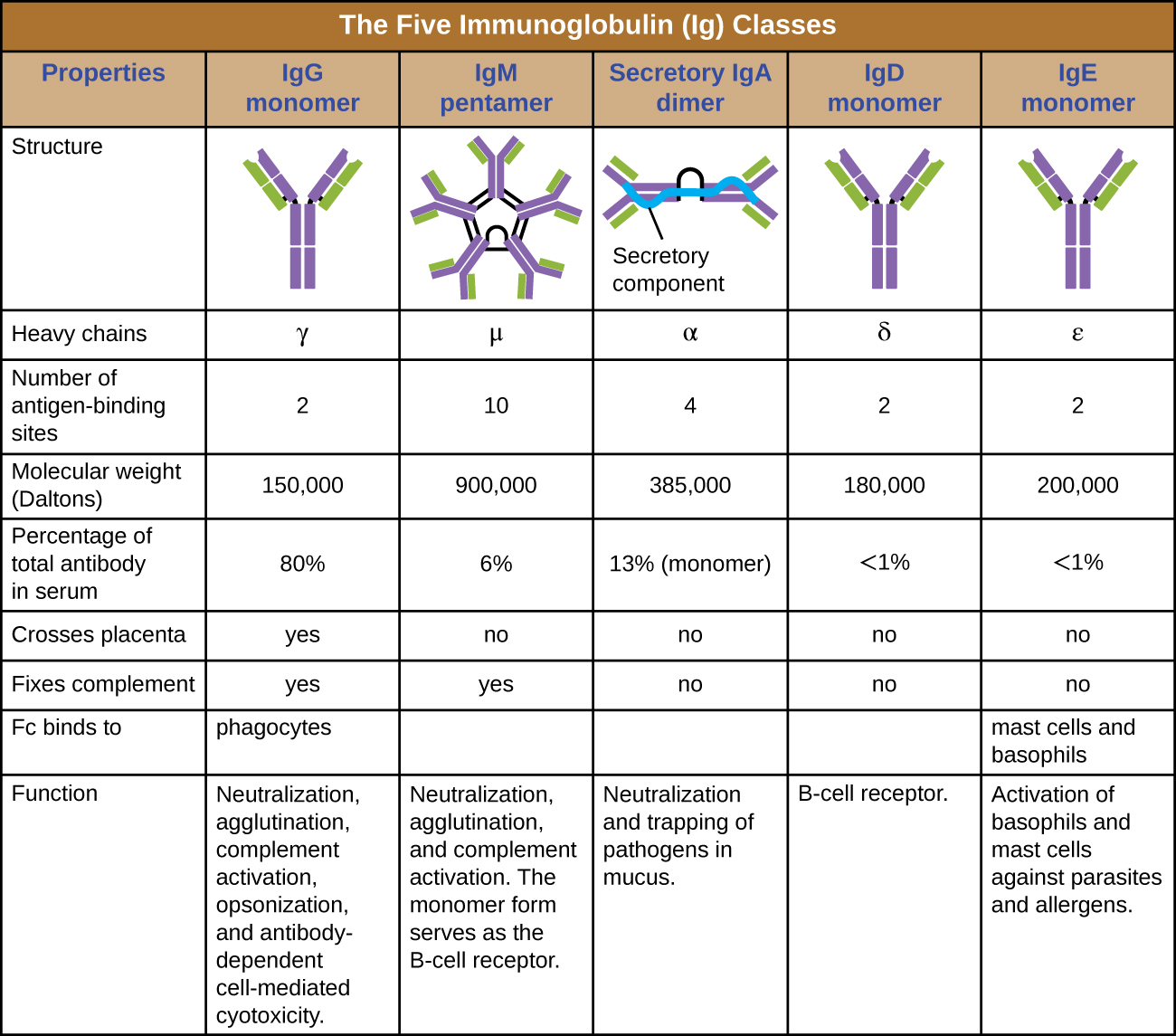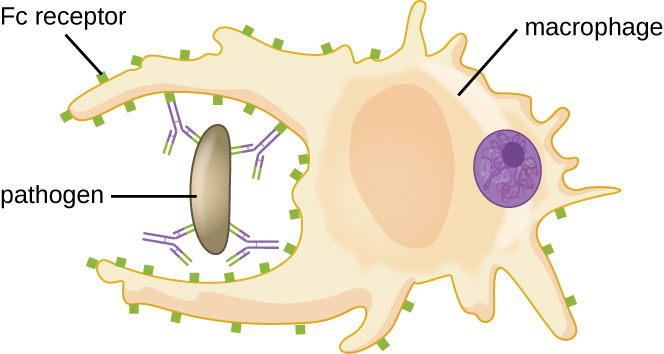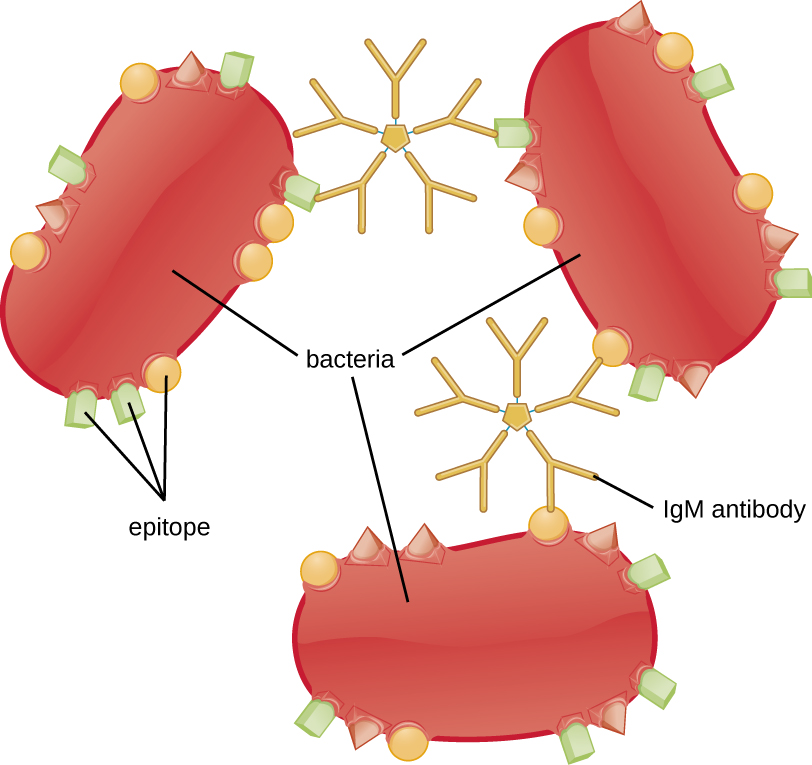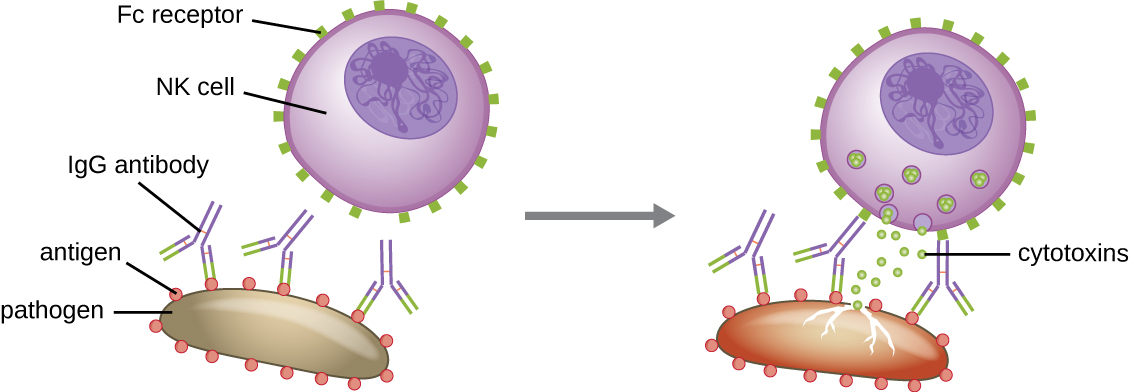| << Chapter < Page | Chapter >> Page > |

Different classes of antibody play important roles in the body’s defense against pathogens. These functions include neutralization of pathogens, opsonization for phagocytosis, agglutination, complement activation, and antibody-dependent cell-mediated cytotoxicity. For most of these functions, antibodies also provide an important link between adaptive specific immunity and innate nonspecific immunity.
Neutralization involves the binding of certain antibodies (IgG, IgM, or IgA) to epitopes on the surface of pathogens or toxins, preventing their attachment to cells. For example, Secretory IgA can bind to specific pathogens and block initial attachment to intestinal mucosal cells. Similarly, specific antibodies can bind to certain toxins, blocking them from attaching to target cells and thus neutralizing their toxic effects. Viruses can be neutralized and prevented from infecting a cell by the same mechanism ( [link] ).
As described in Chemical Defenses , opsonization is the coating of a pathogen with molecules, such as complement factors, C-reactive protein , and serum amyloid A , to assist in phagocyte binding to facilitate phagocytosis . IgG antibodies also serve as excellent opsonins, binding their Fab sites to specific epitopes on the surface of pathogens. Phagocytic cells such as macrophages , dendritic cells , and neutrophils have receptors on their surfaces that recognize and bind to the Fc portion of the IgG molecules; thus, IgG helps such phagocytes attach to and engulf the pathogens they have bound ( [link] ).
Agglutination or aggregation involves the cross-linking of pathogens by antibodies to create large aggregates ( [link] ). IgG has two Fab antigen-binding sites , which can bind to two separate pathogen cells, clumping them together. When multiple IgG antibodies are involved, large aggregates can develop; these aggregates are easier for the kidneys and spleen to filter from the blood and easier for phagocytes to ingest for destruction. The pentameric structure of IgM provides ten Fab binding sites per molecule, making it the most efficient antibody for agglutination.



Another important function of antibodies is activation of the complement cascade . As discussed in the previous chapter, the complement system is an important component of the innate defenses, promoting the inflammatory response, recruiting phagocytes to site of infection, enhancing phagocytosis by opsonization, and killing gram-negative bacterial pathogens with the membrane attack complex (MAC) . Complement activation can occur through three different pathways (see [link] ), but the most efficient is the classical pathway , which requires the initial binding of IgG or IgM antibodies to the surface of a pathogen cell, allowing for recruitment and activation of the C1 complex .
Yet another important function of antibodies is antibody-dependent cell-mediated cytotoxicity (ADCC) , which enhances killing of pathogens that are too large to be phagocytosed. This process is best characterized for natural killer cells ( NK cells ), as shown in [link] , but it can also involve macrophages and eosinophils . ADCC occurs when the Fab region of an IgG antibody binds to a large pathogen; Fc receptors on effector cells (e.g., NK cells) then bind to the Fc region of the antibody, bringing them into close proximity with the target pathogen. The effector cell then secretes powerful cytotoxins (e.g., perforin and granzymes ) that kill the pathogen.

Match the antibody class with its description.
| ___IgA | A. This class of antibody is the only one that can cross the placenta. |
| ___IgD | B. This class of antibody is the first to appear after activation of B cells. |
| ___IgE | C. This class of antibody is involved in the defense against parasitic infections and involved in allergic responses. |
| ___IgG | D. This class of antibody is found in very large amounts in mucus secretions. |
| ___IgM | E. This class of antibody is not secreted by B cells but is expressed on the surface of naïve B cells. |
d, e, c, a, b
There are two critically important aspects of adaptive immunity. The first is specificity, while the second is ________.
memory
________ immunity involves the production of antibody molecules that bind to specific antigens.
Humoral
The heavy chains of an antibody molecule contain ________ region segments, which help to determine its class or isotype.
constant
The variable regions of the heavy and light chains form the ________ sites of an antibody.
antigen-binding
What is the difference between humoral and cellular adaptive immunity?
What is the difference between an antigen and a hapten?
Describe the mechanism of antibody-dependent cell-mediated cytotoxicity.

Notification Switch
Would you like to follow the 'Microbiology' conversation and receive update notifications?